
World's largest book
Encyclopedia
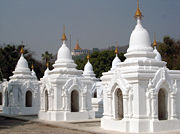
Kuthodaw Pagoda
Kuthodaw Pagoda is a Buddhist stupa, located in Mandalay, Burma , that contains the world's largest book. It lies at the foot of Mandalay Hill and was built during the reign of King Mindon. The stupa itself, which is gilded above its terraces, is high, and is modelled after the Shwezigon Pagoda...
pagoda
Pagoda
A pagoda is the general term in the English language for a tiered tower with multiple eaves common in Nepal, India, China, Japan, Korea, Vietnam and other parts of Asia. Some pagodas are used as Taoist houses of worship. Most pagodas were built to have a religious function, most commonly Buddhist,...
(kuthodaw, "royal merit") at the foot of Mandalay Hill
Mandalay Hill
Mandalay Hill is a 240 metre hill that is located to the northeast of the city centre of Mandalay in Burma. The city took its name from the hill. Mandalay Hill is known for its abundance of pagodas and monasteries, and has been a major pilgrimage site for Burmese Buddhists for nearly two centuries...
in Mandalay
Mandalay
Mandalay is the second-largest city and the last royal capital of Burma. Located north of Yangon on the east bank of the Irrawaddy River, the city has a population of one million, and is the capital of Mandalay Region ....
, Myanmar
Myanmar
Burma , officially the Republic of the Union of Myanmar , is a country in Southeast Asia. Burma is bordered by China on the northeast, Laos on the east, Thailand on the southeast, Bangladesh on the west, India on the northwest, the Bay of Bengal to the southwest, and the Andaman Sea on the south....
(Burma). It has 730 leaves and 1460 pages; each page is three and a half feet wide, five feet tall and five inches thick. Each stone tablet has its own roof and precious gem on top in a small cave-like structure of Sinhalese
Sri Lanka
Sri Lanka, officially the Democratic Socialist Republic of Sri Lanka is a country off the southern coast of the Indian subcontinent. Known until 1972 as Ceylon , Sri Lanka is an island surrounded by the Indian Ocean, the Gulf of Mannar and the Palk Strait, and lies in the vicinity of India and the...
relic casket type called kyauksa gu (stone inscription cave in Burmese
Burmese language
The Burmese language is the official language of Burma. Although the constitution officially recognizes it as the Myanmar language, most English speakers continue to refer to the language as Burmese. Burmese is the native language of the Bamar and related sub-ethnic groups of the Bamar, as well as...
), and they are arranged around a central golden pagoda.
Royal merit
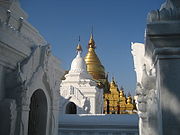
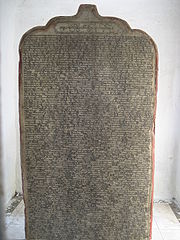
Mindon Min
Mindon Min was the penultimate king of Burma from 1853 to 1878. He was one of the most popular and revered kings of Burma. Under his half brother King Pagan, the Second Anglo-Burmese War in 1852 ended with the annexation of Lower Burma by the British Empire. Mindon and his younger brother Kanaung...
wanted to leave a great work of merit for posterity meant to last five millennia after the Gautama Buddha
Gautama Buddha
Siddhārtha Gautama was a spiritual teacher from the Indian subcontinent, on whose teachings Buddhism was founded. In most Buddhist traditions, he is regarded as the Supreme Buddha Siddhārtha Gautama (Sanskrit: सिद्धार्थ गौतम; Pali: Siddhattha Gotama) was a spiritual teacher from the Indian...
who lived around 500 BC. When the British
Great Britain
Great Britain or Britain is an island situated to the northwest of Continental Europe. It is the ninth largest island in the world, and the largest European island, as well as the largest of the British Isles...
invaded southern Burma in the mid-19th century, Mindon Min was concerned that Buddhist dhamma (teachings) would also be detrimentally affected in the North where he reigned. As well as organizing the Fifth Buddhist council
Fifth Buddhist council
The Fifth Buddhist council took place in Mandalay, Burma in 1871 AD in the reign of King Mindon. The chief objective of this meeting was to recite all the teachings of the Buddha according to the Theravada Pali Canon and examine them in minute detail to see if any of them had been altered,...
in 1871, he was responsible for the construction in Mandalay of the world's largest book, consisting of 729 large marble tablets with the Tipitaka Pali canon
Pāli Canon
The Pāli Canon is the standard collection of scriptures in the Theravada Buddhist tradition, as preserved in the Pāli language. It is the only completely surviving early Buddhist canon, and one of the first to be written down...
of Theravada
Theravada
Theravada ; literally, "the Teaching of the Elders" or "the Ancient Teaching", is the oldest surviving Buddhist school. It was founded in India...
Buddhism
Buddhism
Buddhism is a religion and philosophy encompassing a variety of traditions, beliefs and practices, largely based on teachings attributed to Siddhartha Gautama, commonly known as the Buddha . The Buddha lived and taught in the northeastern Indian subcontinent some time between the 6th and 4th...
inscribed on them in gold. One more was added to record how it all came about, making it 730 stone inscriptions in total.
The marble was quarried from Sagyin Hill 32 miles north of Mandalay, and transported by river to the city. Work began on 14 October 1860 in a large shed near Mandalay Palace
Mandalay Palace
The Mandalay Palace , located in Mandalay, Myanmar, is the last royal palace of the last Burmese monarchy. The palace was constructed, between 1857 and 1859 as part of King Mindon's founding of new royal capital city of Mandalay. The plan of Mandalay Palace largely follows the traditional Burmese...
. The text had been meticulously edited by tiers of senior monks and lay officials consulting the Tipitaka (meaning "three baskets", namely Vinaya Pitaka
Vinaya Pitaka
The ' is a Buddhist scripture, one of the three parts that make up the Tripitaka. Its primary subject matter is the monastic rules for monks and nuns...
, Sutta Pitaka
Sutta Pitaka
The Sutta Pitaka is the second of the three divisions of the Tipitaka or Pali Canon, the Pali collection of Buddhist writings, the scriptures of Theravada Buddhism...
and Abhidhamma Pitaka
Abhidhamma Pitaka
The Abhidhamma Pitaka is the last of the three pitakas constituting the Pali Canon, the scriptures of Theravāda Buddhism....
) kept in royal libraries in the form of peisa or palm leaf manuscripts. Scribes carefully copied the text on marble for stonemasons. Each stone has 80 to 100 lines of inscription on each side in round Burmese script, chiselled out and originally filled in with gold ink. It took a scribe three days to copy both the obverse and the reverse sides, and a stonemason could finish up to 16 lines a day. All the stones were completed and opened to the public on 4 May 1868.
Assembly and contents
The stones are arranged in neat rows within three enclosures, 42 in the innermost, 168 in the middle and 519 in the outermost enclosure. The caves are numbered starting from the west going clockwise (let ya yit) forming complete rings as follows: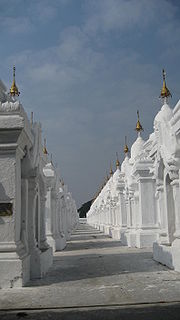
| Enclosure | Cave number | Pitaka |
|---|---|---|
| inner | 1 - 42 | Vinaya Pitaka Vinaya Pitaka The ' is a Buddhist scripture, one of the three parts that make up the Tripitaka. Its primary subject matter is the monastic rules for monks and nuns... |
| middle near | 43 - 110 | Vinaya |
| middle far | 111 - 210 | 111 Vinaya, Abhidhamma Pitaka Abhidhamma Pitaka The Abhidhamma Pitaka is the last of the three pitakas constituting the Pali Canon, the scriptures of Theravāda Buddhism.... 112 - 210 |
| outer nearest | 211 -309 | Abhidhamma |
| outermost perimeter | 310 - 465 | Abhidhamma 310 - 319, Sutta Pitaka Sutta Pitaka The Sutta Pitaka is the second of the three divisions of the Tipitaka or Pali Canon, the Pali collection of Buddhist writings, the scriptures of Theravada Buddhism... 320 - 417, Samyutta Nikaya Samyutta Nikaya The Samyutta Nikaya is a Buddhist scripture, the third of the five nikayas, or collections, in the Sutta Pitaka, which is one of the "three baskets" that compose the Pali Tipitaka of Theravada Buddhism. Because of the abbreviated way parts of the text are written, the total number of suttas is... 418 - 465 |
| outermost next in | 466 - 603 | Samyutta 466 - 482, Anguttara Nikaya Anguttara Nikaya The Anguttara Nikaya is a Buddhist scripture, the fourth of the five nikayas, or collections, in the Sutta Pitaka, which is one of the "three baskets" that comprise the Pali Tipitaka of Theravada Buddhism... 483 - 560, Khuddaka Nikaya Khuddaka Nikaya The Khuddaka Nikaya is the last of the five nikayas, or collections, in the Sutta Pitaka, which is one of the "three baskets" that compose the Pali Tipitaka, the scriptures of Theravada Buddhism... 561 - 603 |
| outermost near | 604 - 729 | Khuddaka |
Thirty years later in 1900, a print copy of the text came out in a set of 38 volumes in Royal Octavo
Octavo
Octavo to is a technical term describing the format of a book.Octavo may also refer to:* Octavo is a grimoire in the Discworld series by Terry Pratchett...
size of about 400 pages each in Great Primer type. The publisher, Philip H. Ripley of Hanthawaddy Press, claimed that his books were "true copies of the Pitaka inscribed on stones by King Mindon". Ripley was a Burmese-born Briton brought up in the royal court of Mandalay by the king and went to school with the royal princes including Thibaw Min
Thibaw Min
Thibaw Min was the last king of the Konbaung dynasty of Burma . His reign ended when Burma was defeated by the forces of the British Empire in the Third Anglo-Burmese War, on 29 November 1885, prior to its official annexation on 1 January 1886....
, the last king of Burma. At the age of 17 he fled to Rangoon
Yangon
Yangon is a former capital of Burma and the capital of Yangon Region . Although the military government has officially relocated the capital to Naypyidaw since March 2006, Yangon, with a population of over four million, continues to be the country's largest city and the most important commercial...
when palace intrigues and a royal massacre broke out after the death of King Mindon, and he had the galley proofs checked against the stones.
Annexation, desecration and restoration
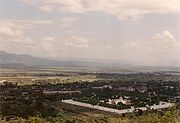
Atumashi Monastery
The Atumashi Monastery is a Buddhist monastery located in Mandalay, Myanmar . It was built in 1857 by King Mindon, two years after the capital was moved to Mandalay. The original monastery structure was built using teak, but burned down in 1890 after a fire in the city destroyed both the...
), Kinwon Min Gyi
Kinwon Min Gyi
Kinwon Min Gyi was a minister under King Mindon's and King Thibaw's reigns. He attempted to westernise the Burmese kingdom's existing bureaucracy into a more democratic system. Because of such attempts to do so, Kinwun Min Gyi was accused by many to have allowed Britain to win the Third...
U Kaung (chancellor), Hleithin Atwinwun (minister of the royal fleet), Yaunghwe Saopha
Saopha
Saopha, Chaofa, or Sawbwa was a royal title used by the rulers of the Shan States of Myanmar . The word means "king" in the Shan and Tai languages...
Sir Saw Maung (a Shan prince
Shan State
Shan State is a state of Burma . Shan State borders China to the north, Laos to the east, and Thailand to the south, and five administrative divisions of Burma in the west. Largest of the 14 administrative divisions by land area, Shan State covers 155,800 km², almost a quarter of the total...
), and Mobyè Sitkè (a general in the royal army). In the tradition of the time, when something needed repair, it was first offered to the relatives of those who had originally made the dana
Dana
-Singers:Some singers are popularly known only by the name, Dana:* Dana Rosemary Scallon , Irish-American singer and politician* Dana , Korean pop singer* Dana International , Israeli pop singer-In fiction:...
(donation) and they came forward and assisted in making repairs. The public was then asked for help, but the full original glory was not achieved.
The gold writing had disappeared from all 729 marble tablets, along with the bells from the hti (umbrella or crown) of each of the small stupa
Stupa
A stupa is a mound-like structure containing Buddhist relics, typically the remains of Buddha, used by Buddhists as a place of worship....
s, and they were now marked in black ink, made from shellac
Shellac
Shellac is a resin secreted by the female lac bug, on trees in the forests of India and Thailand. It is processed and sold as dry flakes , which are dissolved in ethyl alcohol to make liquid shellac, which is used as a brush-on colorant, food glaze and wood finish...
, soot from paraffin lamps and straw ash, rather than in gold, and few of the gems still exist. Mobyè Sitkè also asked permission from senior monks to plant star flower trees (Mimusops elengi
Mimusops elengi
Mimusops elengi is a medium-sized evergreen tree found in tropical forests in South Asia, Southeast Asia, and Northern Australia. English common names include Spanish cherry,, Medlar, and Bullet wood...
) between the rows of kyauksa gus. The inscriptions have been re-inked several times since King Thibaw
Thibaw Min
Thibaw Min was the last king of the Konbaung dynasty of Burma . His reign ended when Burma was defeated by the forces of the British Empire in the Third Anglo-Burmese War, on 29 November 1885, prior to its official annexation on 1 January 1886....
had it done for the second time in gold. The undergrowth amongst the caves was cleared and paved through public donations appealed for in the Ludu Daily
Ludu U Hla
Ludu U Hla was a Burmese journalist, publisher, chronicler, folklorist and social reformer whose prolific writings include a considerable number of path-breaking nonfiction works...
in 1968. The words of the Buddha are still preserved in this place which is therefore a popular destination for devout Buddhists as well as scholars and tourists.

